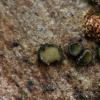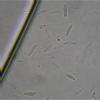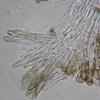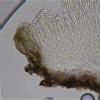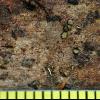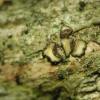
08-01-2026 21:22
 Blasco Rafael
Blasco Rafael
Hola, He recogido esta muestra de Orbilia sobre Re

07-01-2026 10:24
 Danny Newman
Danny Newman
Pezicula sp. on indet. hardwood Appalachian Highl

07-01-2026 22:22
 Danny Newman
Danny Newman
Tatraea sp. on indet. hardwood The Swag, Great Sm

07-01-2026 17:29
 Marc Detollenaere
Marc Detollenaere
Dear Forum,On a barkless Populus I found some smal

10-11-2021 17:33
 Riet van Oosten
Riet van Oosten
Add-on topic http://www.ascofrance.com/forum/7059

07-01-2026 10:05
 Danny Newman
Danny Newman
cf. Chaetospermum on XylariaCosby Campground, Grea

02-01-2026 17:43
MARICEL PATINOHi there, although I couldn't see the fruitbody, I

04-01-2026 17:45
 Stephen Martin Mifsud
Stephen Martin Mifsud
I was happy to find these orange asmocyetes which
 Bonsoir à tous,
Bonsoir à tous,Avez-vous une idée sur ce Mollisia à hymenium vert, récolté et photographié par PY Courrio, sur Eucalyptus, en Bretagne.
Asci 52-58 x 5-5.7, spores 7.5-10.4, septate . KOH negatif
Also if anyone knows a paper about asco on Eucalyptus, thank you for letting me know.
JPP
Photos by PIerre-Yves Courrio

You can check this website for fungi related to Eucalyptus:
http://www.cybertruffle.org.uk/eucafung/eng/index.htm
Raúl
Based on the 1-septate ascospores, relatively short asci, highly melanised inconspicuous marginal cells, and lack of KOH reaction, I would suggest Niptera ramincola Rehm. The ascospores should be septate in living asci. The ascospores in your description are slightly shorter than in the original protologue (10-15 um), but there is quite a bit of ascospore length variation in this species (presumably depending on maturity).
I've collected and ITS sequenced several collections from Wales, (UK) of an identical species – it seems to be a relatively common and generally lignicolous species here. Based on its morphology and ITS sequence it should be regarded as a true Mollisia, and I'm hoping to correct that soon. The best current description of this species is in Ellis and Ellis, Microfungi on Land Plants (1985), p. 11 and Fig. 36.
Cheers,
Brian Douglas

Brian, I have a similar collections than your N. ramicola Rehm. I name these collection Mollisia atlantica Gminder ad interim with have spores septates in ascus, koh -, spores size 7-10 x 2.5 and the excipulum brown in all part, except a thin white margin, conspicious on the first pic. The Courrio collect differs by hymenium too green than usual atlantica with has greyish hymenium becoming cream_yellow.I have attached a picture of what thinks atlantica or perhaps ramicola !
I send to you a personal mail about that.
Amitiés bretonnes
JPP
Longer (and more convoluted) reply sent.
You're right, the provisional Mollisia "atlantica" does seem to be a better species concept, but I suspect that is also what passes for Niptera ramincola here, at least in the sense of Ellis and Ellis. The two species concepts (as I understand them) only really differ in maximum ascospore length (12 vs 15), which may or may not be a good differentiating character depending on apothecial and ascus maturity, or original measurement error.
But, as with all Mollisia spp. we'll need a much larger collection of well-characterised rDNA barcoded species to sort this out.
Cheers,
Brian

Rehm 1896 writes about ramincola "deren sporen beiderseits zugespitz und 14-30 µm lang sind "
What going to say Andreas ???
JPP
As far as I can work out (via Google Translate), here the taxonomic trail gets more complicated:
Karsten originally described Peziza ramealis, a species with ascospores 14-28 um: http://biodiversitylibrary.org/page/13328982#page/535/mode/1up . Peziza ramealis was later transferred to Mollisia then Niptera.
Rehm described some collections from Germany as Niptera ramealisbut noted shorter ascospores 10-15 um long: http://www.biodiversitylibrary.org/item/16235#page/564/mode/1up
Karsten (Hedwigia 1892) disagreed:
"Niptera ramealis Rehm. Krypt. - Flor. Pilz. p. 550, spores obtuse, 10 - 15 mmm long indicated, it is not identical with our Mollisia rameali, whose spores have each apex acute and are longer (14-30 mmm long)." http://archive.org/stream/hedwigia01unkngoog#page/n398/mode/2up
Rehm sees his point, and names it as a new species (Niptera ramincola Rehm), but for some reason only refers back to his original description without redescribing the spore length. Rehm says it is different from Niptera ramealis Karst. (which has longer spores of 14-30 um length, pointed at both ends). http://archive.org/stream/drlrabenhorstskr0103rabe#page/1264/mode/2up
So (as far as my translating ability goes) it looks like the type description of Niptera ramincola Rehm does include 1-septate ascospores of 10-15 um with rounded ends.
If this is all correct, the question is: do our collections and Mollisia "atlantica" resemble the type description sufficiently to be the same species? Are they genetically the same species? Does the ascospore variation within our collections range up to 15 um (mine only go up to 12 um)? If not, could Rehm's measurements be slightly wrong?
To resolve this, I think we need an ITS sequenced epitype (and several other collections) from rotting wood of birch and oak in the Grunewald in Berlin, which is where Sydow found the original collection. If that matches our collections and Andreas' Mollisia "atlantica", then these collections should probably should be called Mollisia ramincola.
Of course, if anyone has any other opinions, or better Latin/German translating ability than Google Translate, I would be very glad to hear it!
Cheers,
Brian


